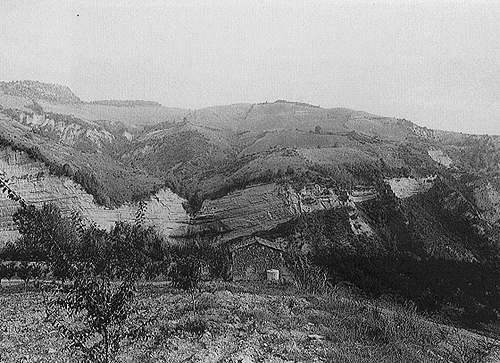
Sedimentary bodies: sandstone tongue and onlap
Plate 11

Sedimentary bodies: sandstone tongue and onlap
Plate 11
A set of sandstone beds pinches out in a mudstone sequence, barely visible on the right. As indicated by morphology, mudstones lie also on top of this tongue. When dealing with wedge- or lens-shaped bodies, a question to be resolved is the following: were they relieves that bulged up from an Ancient flat surface, or the filling of a depression such as a channel or a valley? It is implied, in the first case, that the base of the body was horizontal, and the top convex up; in the second, that the base was concave up, possibly owing to erosion, and the top horizontal.
The solution consists in finding the regional bedding attitude and suitable guidelines (datum planes ) for paleo-horizontality. Here, the sequence is slightly dipping to the left. The sandstone body is made of parallel beds, which are also parallel to the upper boundary of the set; instead, they make an angular contact with the basal surface of the tongue. The top is also parallel to the general attitude. Therefore, it can be assumed that it coincides with a paleohorizontal surface. If this is true, the beds abutting against the inclined base are said to lap on it, or to make an onlap contact (compare with downlap in plate 12). In other words, they are less inclined than the surface on which they rest. The conclusion is, that horizontal beds filled a trough by vertical accretion.
Marnoso-arenacea Formation, Santerno Valley, northern Apennines.